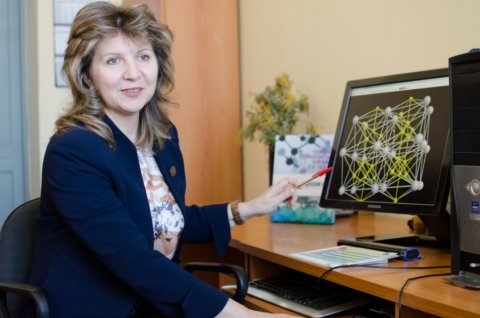This year, the Laboratory for Multi-Scale Simulation of Multicomponent Material at the Research and Education Center Nanotechnology (Institute of Natural Sciences) has received a grant for completing project part of a governmental task aimed at researching the influence of non-covalent interactions’ type on physical and chemical property of materials. While working on the project, the laboratory scientists are fully engaged in International Symposiums by presenting reports and regularly publishing their articles in journals indexed in the Web of Science database. For example, an article of SUSU scientists concerning electronic capability of iodine halogen bonds in crystals has been recently published in the first-quartile journal Acta Crystallographica Section B: Structural Science, Crystal Engineering and Materials. Graphical abstract of the article has been used as a cover of the edition. Laboratory Head Ekaterina Bartashevich told us about the importance of the conducted research.
- What is the main point of the research supported by the received grant?
- This is one of three grants of the Ministry of Education and Science of the Russian Federation, aimed at supporting projects pursued by universities’ laboratory scientists, and which our university won this year. Our research is considered fundamental; we study the properties of chemical bounds and, which is important, non-covalent interactions. Physicists study properties of substances, and we, chemists, can create new substances. These are non-covalent interactions’ peculiarities that form physical and chemical properties of the entities, and therefore define the properties of materials. In order to obtain new (materials), it is important to study fundamental basics and know how chemical bounding influences the properties of a substance. This is exactly what we do at the laboratory. Just as you can design clothes, apparatus or engine, chemical entities are also can be and need to be designed. As a result the process of developing effective materials with the required properties becomes much cheaper and more efficient.
- What is the students’ role in the laboratory operating?
- Many young people are working at our laboratory. Their excellent skills in working on computers help them designing chemical structures, solving mathematical problems in chemistry and keep in touch with the whole world. There are students of practically all educational levels (working at the laboratory). Several Bachelor students majoring in chemistry are working on their graduation thesis; Master’s degree students are also working in our laboratory; and postgraduates are conducting research for their dissertations. Our laboratory is always open for those who are interested in electronic level of substance constitution, and in perspectives of developing effective materials of the future.
- What is the uniqueness of your laboratory?
- There are several levels in the conducted multi-scale simulation of material structure. We embrace different levels: monocrystals, nanoclusters, molecules, atoms, and also the subatomic level – it is what happens to the electron density when atoms interact with each other. This level is very important for understanding, which chemical bound will be formed in the new entity, and how stable it will be. Combination of all the levels of structure simulation with the level of analysis of the electron density – is what makes our simulation different from the others. It is surely not easy to work at a laboratory, you need to be able to work with literature in English, and have skills of writing in it. SUSU Academic Writing Office helps us a lot by giving us the priceless opportunity to learn how to write abstracts and articles in English.
.jpg)
- What is the publication level of the laboratory workers?
- We have set a high bar, so we aspire to qualitative growth of our publications. Scientists should constantly publish the results of their research. Preparing publications in top-rated journals with high impact factors – is hard and serious work, it requires patience. Sometimes it is hard to stand up to the opponents, and the reviewers’ comments can be very strict, but we keep trying to do our best: we correct mistakes, find proves and teach our young scientists how to join a discussion correctly. Following the example of our experienced scientists Irina Yushina and Yuri Matveychuk, young scientists realize that it is possible to really compete for priorities, achieve and maintain high level of their publication activity. Therefore our students are doing their best.
- Will the research go on in the future?
- This is the first year out of three for completing this project. The scientific inquiry itself is of great importance, but we simultaneously teach our young researches to carry out such inquiry. Young scientists start their research activity at the university, and whether anyone of them will reflect glory upon national science usually depends on this stage. Everybody dreams of getting unique results, and if the effective properties of materials can be improved in the end – than it becomes a real victory.




